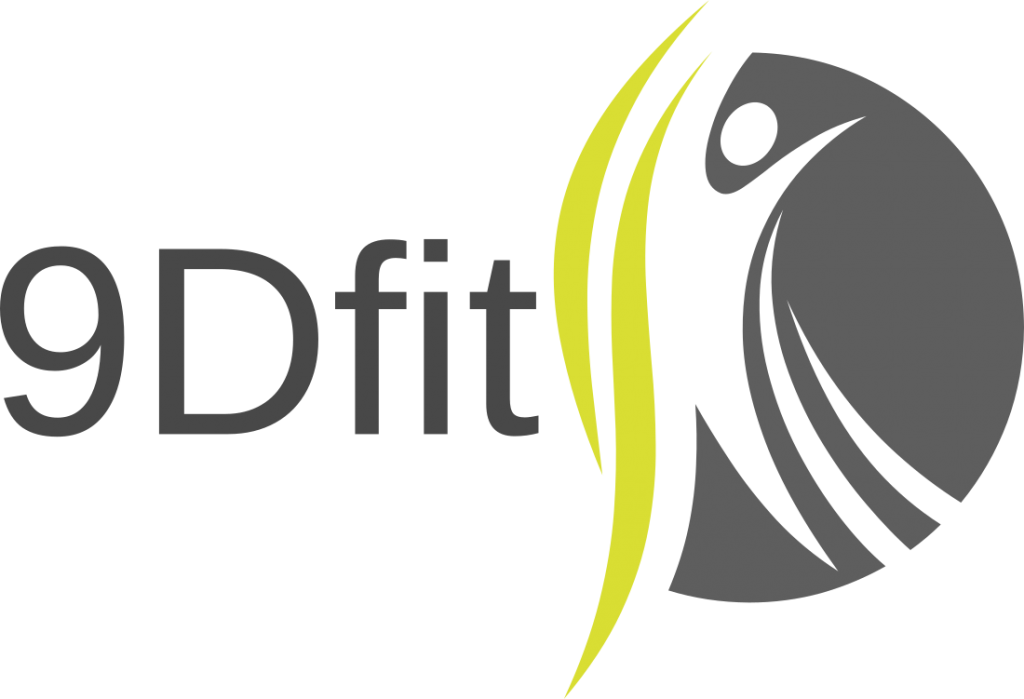By Jason Shea M.S., CSCS, PICP IV
Did you know that research has shown that a single college wrestling match can elevate blood lactate concentrations “in excess of 15 mmol/L and sometimes reach nearly 20 mmol/L (6)”?
In comparison, a 2017 study on 60 professional soccer players found peak lactate levels of 12.5 mmol/L post game (8). A study on college football players found halftime lactate levels peaked at roughly 4.40 mmol/L, while post game levels rose to 5.08mmol/L (9).
A sport that may see similar blood lactate levels to that of wrestling is the sport of Strongman. A 2007 study out of the Journal of Strength and Conditioning Research found an average blood lactate of 15.6 mmol/L (peak of 16.1 mmol/L) when pushing or pulling a motor vehicle 400 meters (2). The blood lactate levels were 131% greater than those found in maximal treadmill running (2).

In a 2014 study, researchers had subjects perform a sled drag workout that consisted of 5 sets of two 20-m sled drags (30 seconds between drags per set) with 120 seconds of rest between sets. The sleds were loaded with 75% of each subjects body mass and were dragged across an indoor running surface. The researchers found blood lactate levels peaked at 12.4 mmol/L after the drags (10).
Research done on tire flips found blood lactate levels of just over 10 mmol/L after subjects performed 2 sets of 6 tire flips with a 232kg tire. The subjects were given 3 minutes of rest between each set (4).
According to 2004 study/analysis by world renowned sport scientist Dr. William Kraemer;
“wrestlers must be able to buffer the high-acidic muscle and blood concentrations in order to demonstrate optimal strength and power during training and competition. The ability to tolerate this acid-base disruption with the body’s inherent intracellular (bicarbonate) and intercellular (phosphate) buffering systems is a trainable phenomenon. This requires performing resistance training with short rest intervals or traditional cardiovascular interval training.
Adaptation will typically take about 8 weeks to achieve, which demonstrates the need for preseason conditioning programs that begin during the summer months. It is also vital that the upper body is trained in this manner to increase the capability of upper-body musculature to directly adapt to the dramatic acid-base shifts that occur with wrestling.
One should allow a 4- to 6-week time frame summary to make the gradual reductions in rest periods. Once a rest time of 60 seconds is reached, 6 to 8 weeks will be needed to optimize buffering capacity (6).”
Functional Strength
Modified strongman training can be a very effective tool in building functional strength in wrestlers (and most other athletes). Modified strongman training can increase low back strength, upright stability, grip strength, lactate tolerance, connective tissue integrity, while improving mental toughness and resilience.
No longer a training method typically reserved for 300+ pound strength athletes, modified versions of strongman exercises have become a mainstream training method. Commercial health clubs have added variations of strongman training including sandbags, farmer carry handles, battle ropes, sled drags, and hand over hand rope pulls. Cross training centers now have an array of tires, slosh sticks, kegs, atlas stones, sleds, and more.
Elite performance training centers geared toward the highest level of athletics may use a combination of strongman, Olympic lifting variations, and practical programming to create the foundation for optimal athletic performance.
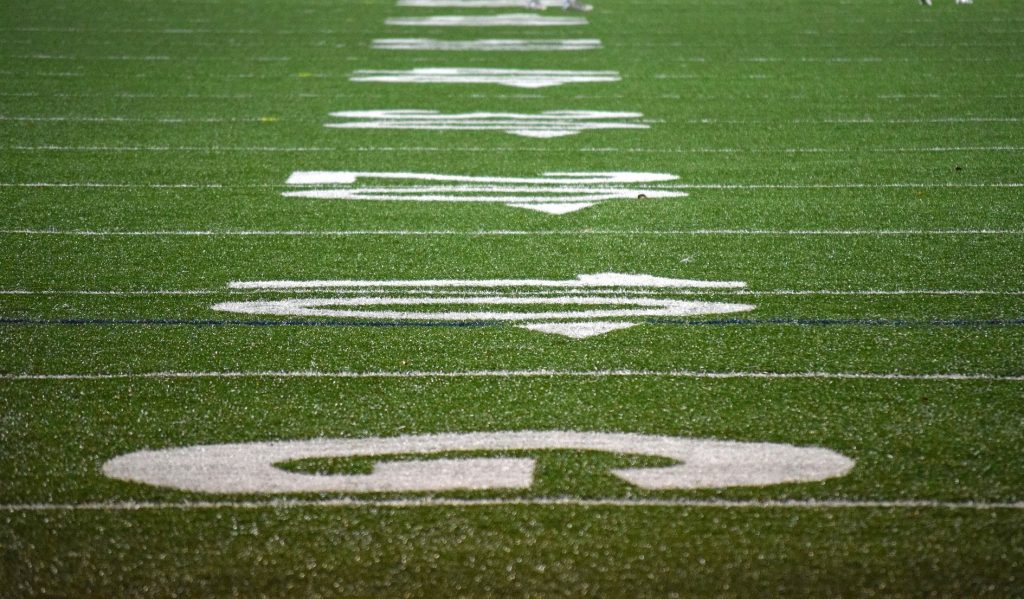
Strongman training bridges the gap between the weight room and on-field performance. It emphasizes multi-directional/planar, multi-segmental strength, similar to that found in wrestling.
Due to the fact that most strongman exercises are ground based with dynamic movement, their transfer effect to the field is very high. For example, a Division I men’s rugby team here in the northeast, invested in strongman training as a part of their off-season preparation. The team went from not even qualifying for the national men’s tournament the year before, to a highly successful season that eventually culminated in a Division I National Final Four appearance.
Variations of Strongman training have been adopted by Law Enforcement as well. At many police academies, recruits can be seen performing exercises such as dummy drags and hand over hand rope pull variations as a part of their training curriculum. Navy SEALS have been known to carry and drag telephone poles in BUDS training, while SWCC operators have made great use of Hauser lines.
SWAT teams compete against other regional SWAT teams in yearly competitions. The teams are required to complete an obstacle course, typically a few miles in duration, in which tactical skills and physical abilities are meshed into one team workout. The tactical skill set revolves around tasks associated with their work, while the physical abilities is a combination of endurance and modified strongman exercises. From tire flips and atlas stone carries, to lifting and hoisting awkward implements, these tests are truly a measure of physical and mental capacity.
A study by McGill et al found strongman training to be a highly effective training tool for increasing upright stability. The researcher team stated that “each event challenges the body linkage and the stabilizing system in a different way so that the weak link will be found (7)”. They concluded that the carrying events “would enhance traditional lifting-based strength programs (7).”
10 Benefits of Strongman Training
- Improves Lower Back Strength: Tire flips. Atlas Stone. Keg Carries. Farmer Carry. Log Press. Husafell Stone. Hand over Hand Pulls. Anchor Drags. Wheelbarrow. Sled Pulls. Etc. All of these require tremendous amounts of low back strength.
- Strengthens joints and tendons: With stronger joints and tendons an athlete decreases the risk of injury while simultaneously increasing the ability to generate more force.
- Increases alactic power and capacity: Strongman training increases both the ability to generate high levels of force as well as increasing an athlete’s anaerobic capacity.
- Develops powerful hip extensors: “Strong hips” are critical for success on the mat and in many other sports.
- Improves Structural Balance: Strongman training places a great degree of emphasis on the posterior chain muscles (those not seen in the mirror). This will help to create balance between posterior and anterior antagonistic muscle groups.
- Increases ankle integrity: Walking/jogging with an unbalanced or awkward load can place high amounts of compressive force on the ankle. Think of the jeep commercials in which the vehicle’s suspension is seen going over rocky obstacles, flexing and absorbing force in all directions to maintain stability. The human ankle works in the same fashion. Adding functional resistance with strongman apparatus’ increases these forces, strengthening the musculature around the ankle and increasing the integrity of the joint.
- Strengthens Core Musculature: The core consists of the muscles of the front, side, and back of the lumbo-pelvic-hip region. To stabilize the torso during any strongman exercise, there needs to be a high level of core musculature activation. From tire flipping to farmer’s carries, your core musculature can strengthen to a far greater functional capacity than crunches and planks.
- Increases muscular endurance: During long matches, the ability to generate force in flurries over consecutive and non-consecutive bouts, distinguishes which competitors succeed and which fail.
- Improves grip strength: A 2001 study found grip strength dropped by over 30% over the course of 2-day 5 match tournament (5). Strongman training is a great method of building both grip strength and grip endurance.
- Mental toughness: After one or two difficult, lactate inducing, strongman training sessions, an athlete quickly realizes it takes mental toughness to complete this type of workout.
Transfer of Training
Who would you rather have standing across from you on the wrestling mat, former World’s strongest man Hafþór Björnsson or the current world record holder in plank hold?
Conventional strength exercises including squats and deadlifts at 80% of one’s 1 rep max have been found to have significantly greater muscle activation of the core compared to horizontal isometric core targeted exercises (3). Other studies have shown that walking with a load further increased rectus abdominis activation by 132%, when compared to standing (1). All the more reason to include strongman protocols into your training regimen.
Recovery and Workload
Strongman can be taxing on the nervous system. If you are concerned with under-recovering, a simple method (aside from vertical jump and Omega Wave) of testing for physical preparedness is the hand grip strength test first thing in the morning.
![Science of Sports Training: How to Plan and Control Training for Peak Performance by [Thomas Kurz]](https://m.media-amazon.com/images/I/51EApSGIlhL.jpg)
In his book Science of Sports Training, sport scientist Thomas Kurz recommended the measurement of handgrip strength using a hydraulic dynamometer to reveal the physical readiness of an athlete. This information provides valuable data to the coach regarding the athlete’s ability to recover from workouts. This theory draws parallel to the findings of studies performed by Sasaki et al (1999), Hunt et al (1985), and Frederiksen et al (2002), and Dodds et al (2014).
Now that we have seen why modified strongman training is important, let’s delve into the exercises and workout examples.
Strongman Exercises
6 Strongman Exercises for Wrestlers
- Tire Flips: Do not attempt to deadlift and curl the tire. This is a recipe for disaster as the stress on the shoulders and elbow flexors can lead to a rupture of the bicep tendon. Instead position your hands under the tire, wider than shoulders with arms extended or slightly bent. Rest the top of your chest and anterior part of the shoulders against the top edge of the tire, with your chin down on top of the tire. Position your feet under your hips or slightly behind, with hamstrings resting on calves and knees even with or just inside the elbows. The back remains in neutral or slightly lordotic posture with heels off the ground in the start position. Begin by extending the hips, with your rigid torso creating a wedge between your legs and the tire, driving the tire forward and up. Once the bottom side of the tire is hip height, extend at the hips and drive a knee forward and upward into the tire while pushing the tire up and over with your hands.
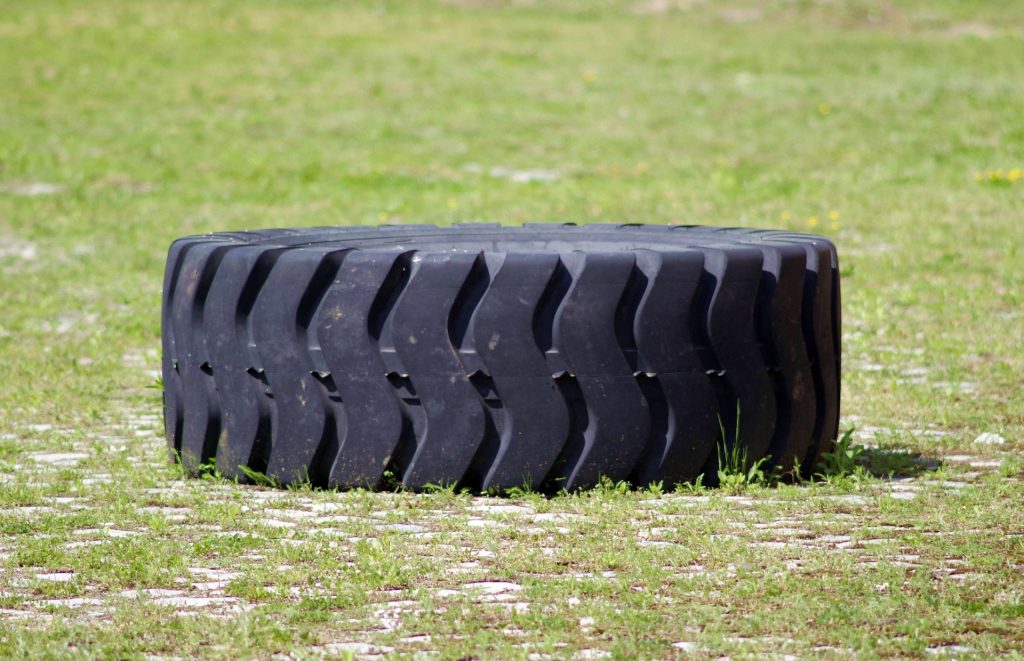
Often, after a difficult tire session, athletes will not only experience posterior chain soreness, but also forearm flexor soreness for the next couple of days.
2. Sled or Dummy Drag: This versatile tool allows for forward, backward, and lateral pulling. It can be used as a strengthening, rate of force development, or metabolic conditioning tool. Whether training distance, speed, explosiveness, or strength, the benefits for the combat/grappling athlete can numerous.
Two versions of the backward sled drag are the hips extended and hips bent versions. For the hips extended version, face the sled and grab the sled handles. Lean your torso backward, with hips fully extended. Feet should be no wider than hip width apart. Keeping the hips extended and torso leaning back, begin taking small strides backward, focusing on driving through the ball of the foot for greater VMO muscle recruitment.
The hips bent sled drag consists of the same set up, but the hips and knees are bent, with the upper thigh parallel to the floor and torso perpendicular to the floor with shoulder blades retracted back. The upper thigh and relative torso position remain the same throughout the entire exercise. Without raising the butt upward or leaning forward, begin “moon-walking” backward, dragging one foot backward while completely extending the opposite side leg. The foot stride is very short, with the non-working foot only dragged back until the toe is even with the opposite heel.

According to Charles Poliquin’s excellent, must have book Applied Strongman Training for Sport:
- Smaller Females should be able to backward drag 150-200lbs
- High School Males and Female Strength athletes: 200-350lbs
- Collegiate Males should be able to backward drag 350-500lbs
- Male strength athletes should be able to backward drag 500+ lbs
- Pull-through and Hamstring Drag resistance should be within 15-20% of backward drag.
In this book, coach Poliquin gives 3 specific sled dragging workouts, one in which he used to help St. Louis Blues star Dallas Blake recover from knee surgery and another in which he prescribed to New Jersey Devils enforcer Jim McKenzie. Pick up a copy of the book for those programs and much more.
3. Farmer Carry: Along with their positive benefits on grip strength, shoulder, low back, hip, and quadriceps musculature, all of which lead to transferable effects on one’s functional strength on the mat.
Stand between two Farmer carry handles in proper deadlift position, with hands equidistant between the edges of the hand grips. Holding a rigid neutral or lordotic spinal posture, deadlift the handles up to your sides. Begin carrying the handles for set distance or time, maintaining control of the body and handles.
According to Poliquin, “coaches and athletes should strive for loads equaling their 5-rep max in the full back squat for the total weight of the handles. Superior athletes will use greater than this percentage. It is not uncommon to see 115-120% of body weight per hand for testing purposes (Poliquin).”

4. Hand over Hand Rope Pull: Attach a long rope to a dragging sled. Sit down with knees slightly bent, holding the rope at the opposite end with feet anchored against a brace. Reach forward and begin pulling the rope hand over hand while extending the torso and hips backward. Maintaining your vision straight ahead, try to maintain a slightly rigid posture, creating an efficient rhythm between arm pull and torso/hip extension. Rope climbing is another great option.
5. Keg/Sandbag Carries: Carrying and loading asymmetrical objects has been shown to recruit up to 132% greater rectus abdominis activation than stationary standing exercises (1). While walking with an asymmetrical object, not only are you strengthening your lower extremities, upper and lower back, grip, and elbow flexors, but your abdominal musculature is also working overtime to maintain spinal pressurization to keep the torso upright. Done for time or in medley fashion, this can be very taxing.
6. Prowler/Sled Push: The prowler/sled push be used as a training method for both rate of force production and functional strength in the horizontal plane. As we saw in the studies at the beginning, prowlers/sleds/ and cars can also be a great gut wrenching, blood lactate inducing, metabolic conditioning tool.
Sample Workouts
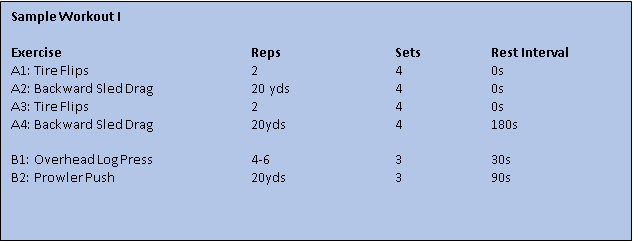

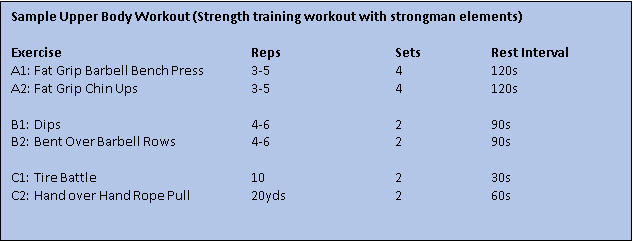
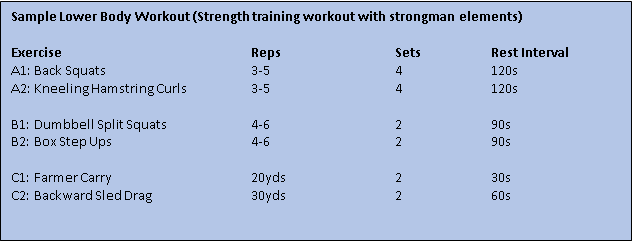

Thx for reading and stay tuned for Part 4 of The Importance of Low Back Strength in Wrestling: Power Training. If you missed them, be sure to check out part 1 and part 2 of this series and sign up for the newsletter for all the latest info!
References
- Anderson et al. A biomechanical analysis of anterior load carriage. Ergonomics. 50(12); Pp 2104-2117. 2007.
- Berning et al. Metabolic demands of junkyard training: pushing and pulling a motor vehicle. Journal of Strength and Conditioning Research. 21: Pp 853–856. 2007
- Hamlyn et al. Trunk muscle activation during dynamic weight-training exercises and isometric instability activities. Journal of Strength and Conditioning Research. 21(4); Pp 1108-1112. 2007,
- Keogh, J. A Brief Description of the Biomechanics and Physiology of a Strongman Event: The Tire Flip. Journal of Strength and Conditioning Research. 24(5); Pp 1223-1228. 2010.
- Kraemer et al. Physiological and performance responses to tournament wrestling. Medicine and Science in Sports and Exercise. 2001.
- Kraemer et al. The Physiological Basis of Wrestling: Implications for Conditioning Programs. National Strength and Conditioning Association Journal. 26(2); Pp 10-15. 2004.
- McGill et al. Comparison of different strongman events: trunk muscle activation and lumbar spine motion, load , and stiffness. Journal of Strength and Conditioning Research. 23(4); Pp 1148-1161. 2009.
- Santos-Silva et al. Blood lactate and oxygen consumption in soccer players: comparison between different positions on the field. Medical Express (Online). 4(1); 2017.
- Smith ME, Jackson CGR. Lactate response of college football players to practices and a game [abstract]. Journal of Applied Sport Science Research; 5: Pp 163. 2001.
- West et al. The metabolic, hormonal, biochemical and neuromuscular function responses to a backward sled drag training session. Journal of Strength and Conditioning Research. 28: Pp 265-272. 2014.
